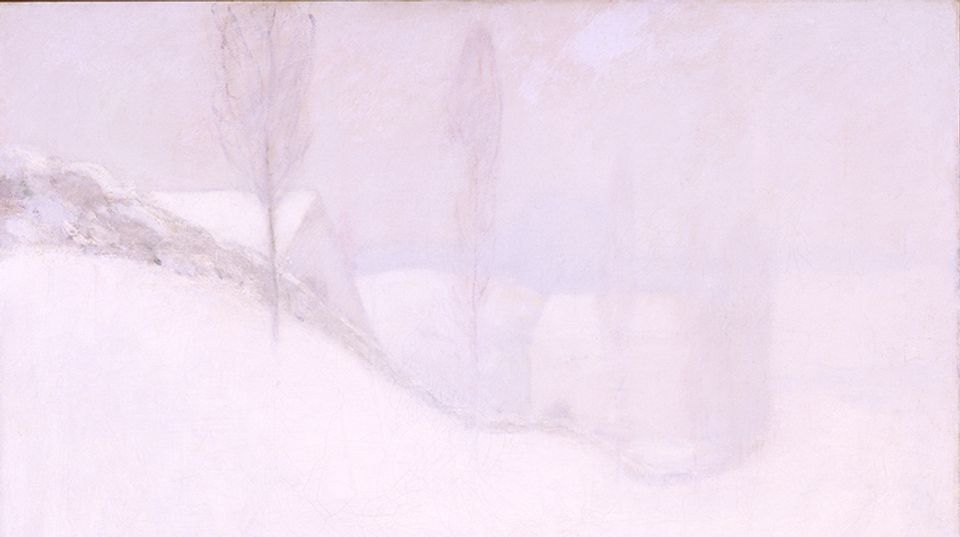
Silent Orchestra performs a score for Nosferatu. Photo © Bruce Guthrie.
Silent Orchestra will be performing a live score for the classic silent film Salomé on Saturday, August 7, at 3:00 p.m. Free tickets will be distributed in the G Street Lobby thirty minutes before the program begins.Allison Jessing, public programs coordinator for American Art and the National Portrait Gallery, spoke with orchestra members Carlos Garza and Rich O'Meara about their work.
Eye Level: How do you choose the films that you work with, and what draws you to them?
Silent Orchestra: Often a museum or gallery chooses the films for a live performance. Our style lends itself well to genres that include drama, fantasy, suspense, or darker subject matter. Since we work mainly with silent film, we are drawn to those that have a strong sense of mood or atmosphere that suggests musical interpretation. Silent films that tell their story largely with visuals rather than title cards or written dialogue seem to inspire us more. Some examples are the films of F. W. Murnau, Germaine Dulac, and Marcel L'Herbier.
EL: What musical styles influence your compositions?
SO: We are inspired by many of today's film composers. Some favorites are Thomas Newman, Danny Elfman, Jerry Goldsmith, Alberto Iglesias, Eric Serra, Ennio Morricone, Bernard Herrmann, and Hans Zimmer. We like to combine acoustic percussion with electronic sounds that range from symphonic to music concrete. Other influences of course tend to be artists that use these sounds in different ways or classical composers who have a sharp rhythmic sense and are innovative. Some that come to mind are Brian Eno, Stravinsky, Bartok, Steve Reich, Debussy, Harry Partch, Aphex Twin, Louis Sclavis, Happy the Man, and John Hollenbeck.
EL: How do you begin the process of collaboratively composing for a silent film?
SO: After watching the film a few times, we create a list of cues with timings. Then we discuss how the music can support the meaning in the film by highlighting a character's mood, evoking the period or location, or connecting scenes or characters. For example, we sometimes compose a leit motif, or theme, for the main characters, so that the viewer can identify with the parts of the film in which that character is important.
Sometimes the music is designed to affect the viewer's perception of time or space, as in the travel sequences in Nosferatu (1922, F. W. Murnau). Occasionally, the music is designed to be diegetic, or part of the story, as in the veil dance in Salomé (1923, Charles Bryant), where our score imagines what the band might be playing for Salomé's dance. For L'Inhumaine (1924, Marcel L'Herbier), which we performed at the National Gallery of Art, we added a singer to vocalize for the main character who sings in the story.
We always improvise with the film and record the sessions. Then we can find music that really seems to work and make a notated sketch, so we can recreate it each time. These sections tend to grow as we continue to improvise and see new things in the film.
EL: How do different elements of the film—cinematography, acting, directing—inspire you during the creative process?
SO: As we said earlier, we look at each section of the film and figure out how best to support the story. Sometimes a particular character demands a theme to highlight certain qualities. For Something New (1920, Nell Shipman), we wrote heroic music for the dog.
In Nosferatu, we keyed on Murnau's interest in expressionism and developed the sound palette around some of the materials in the film. For example, we used wooden sounds, warped sounds, metalic scraping, and repeating sections of music at different lengths to evoke the twisted world that the protagonists experience.
EL: Does Silent Orchestra have any new projects on the horizon?
SO: We've scored contemporary short films and performed live improvisation for nonnarrative moving images and look forward to doing that again. We are keen on working with modern directors who experiment across the full range of film elements, such as lighting, special effects, sound design, and of course the use of music to convey meaning.
We have recently released a "revamped" version of our Nosferatu soundtrack from the Image Entertainment DVD. It is available at most online download sites and from CD Baby. We also have plans to release the Salomé score on CD and download.
We have enjoyed playing Nosferatu at AFI Silver, in Silver Spring, Maryland, for several years on Halloween. It has become a holiday tradition. Look for us there. We have also been working on a Metropolis (1927, Fritz Lang) score and are looking for an opportunity to bring that to the public.

















